引言:被忽略的作用域陷阱
在Spring框架的日常开发中,@Scope("prototype")与@RequestScope是两个高频使用的作用域注解。前者确保每次获取Bean时创建新实例,后者则将Bean的生命周期与HTTP请求绑定。然而,当开发者试图在同一个Bean上同时使用这两个注解时,往往会陷入一个隐蔽而棘手的陷阱——作用域冲突。
这种冲突并非简单的编译错误,而是会导致一系列难以排查的运行时问题:有时Bean的实例会意外复用,有时会抛出"无请求上下文"的异常,更严重的情况下,甚至会出现用户数据交叉污染(如A用户的请求数据被B用户获取)。这些问题的根源在于开发者对Spring作用域的底层机制理解不足,以及对"作用域语义互斥"这一核心原则的忽视。
本文将从Spring作用域的设计原理出发,深入剖析@Scope("prototype")与@RequestScope的冲突本质,提供7种经过实践验证的解决方案,并总结作用域使用的最佳实践,帮助开发者彻底规避这类问题。
一、Spring作用域的底层逻辑:从设计到实现
要理解作用域冲突的本质,必须先掌握Spring作用域的底层运行机制。Spring的作用域设计并非简单的"实例创建规则",而是一套完整的生命周期管理体系,涉及实例创建、缓存、代理、销毁等多个环节。
1.1 作用域的核心定义与分类
Spring通过Scope接口定义了作用域的核心行为,所有作用域的实现都必须遵循这一规范:
public interface Scope {
// 获取作用域内的Bean实例(不存在则创建)
Object get(String name, ObjectFactory<?> objectFactory);
// 移除作用域内的Bean实例
Object remove(String name);
// 注册Bean销毁时的回调方法
void registerDestructionCallback(String name, Runnable callback);
// 解析上下文对象(如request/session)
Object resolveContextualObject(String key);
// 获取作用域的唯一标识(如请求ID、会话ID)
String getConversationId();
}
在Spring的默认实现中,有5种常用作用域,其中prototype和request是Web开发中最易冲突的两个:
| 作用域 | 实例创建时机 | 生命周期边界 | 核心实现类 | 典型应用场景 |
|---|---|---|---|---|
| singleton | 首次注入/获取时 | Spring容器启动至销毁 | SingletonScope | 无状态服务、工具类 |
| prototype | 每次注入/获取时 | 由开发者手动管理(Spring不销毁) | PrototypeScope | 有状态命令对象、请求参数封装 |
| request | 首次在请求中使用时 | HTTP请求开始至响应完成 | RequestScope | 请求上下文、用户身份快照 |
| session | 首次在会话中使用时 | 用户会话创建至失效 | SessionScope | 购物车、用户偏好设置 |
| application | 首次在Web应用中使用时 | Web应用启动至关闭 | ApplicationScope | 应用级配置、全局缓存 |
1.2 prototype作用域:"每次获取都是新实例"的真相
prototype作用域的核心逻辑由PrototypeScope类实现,其get方法的源码揭示了"每次获取新实例"的本质:
public class PrototypeScope implements Scope {
@Override
public Object get(String name, ObjectFactory<?> objectFactory) {
// 直接通过ObjectFactory创建新实例,不做缓存
return objectFactory.getObject();
}
@Override
public Object remove(String name) {
// prototype实例不由Spring管理,返回null
return null;
}
@Override
public void registerDestructionCallback(String name, Runnable callback) {
// 不支持销毁回调(实例生命周期由开发者控制)
logger.warn("Destruction callbacks not supported for prototype scoped beans");
}
// 其他方法省略
}
关键特性:
- Spring容器不会缓存prototype实例,每次调用
getBean()或注入时,都会通过ObjectFactory创建新对象。 - prototype实例的销毁不受Spring管理,即使Bean实现了
DisposableBean接口,destroy()方法也不会被自动调用。 - 当prototype Bean被单例Bean依赖时,单例Bean会长期持有首次注入的prototype实例,导致prototype的"新实例"特性失效(需通过代理解决)。
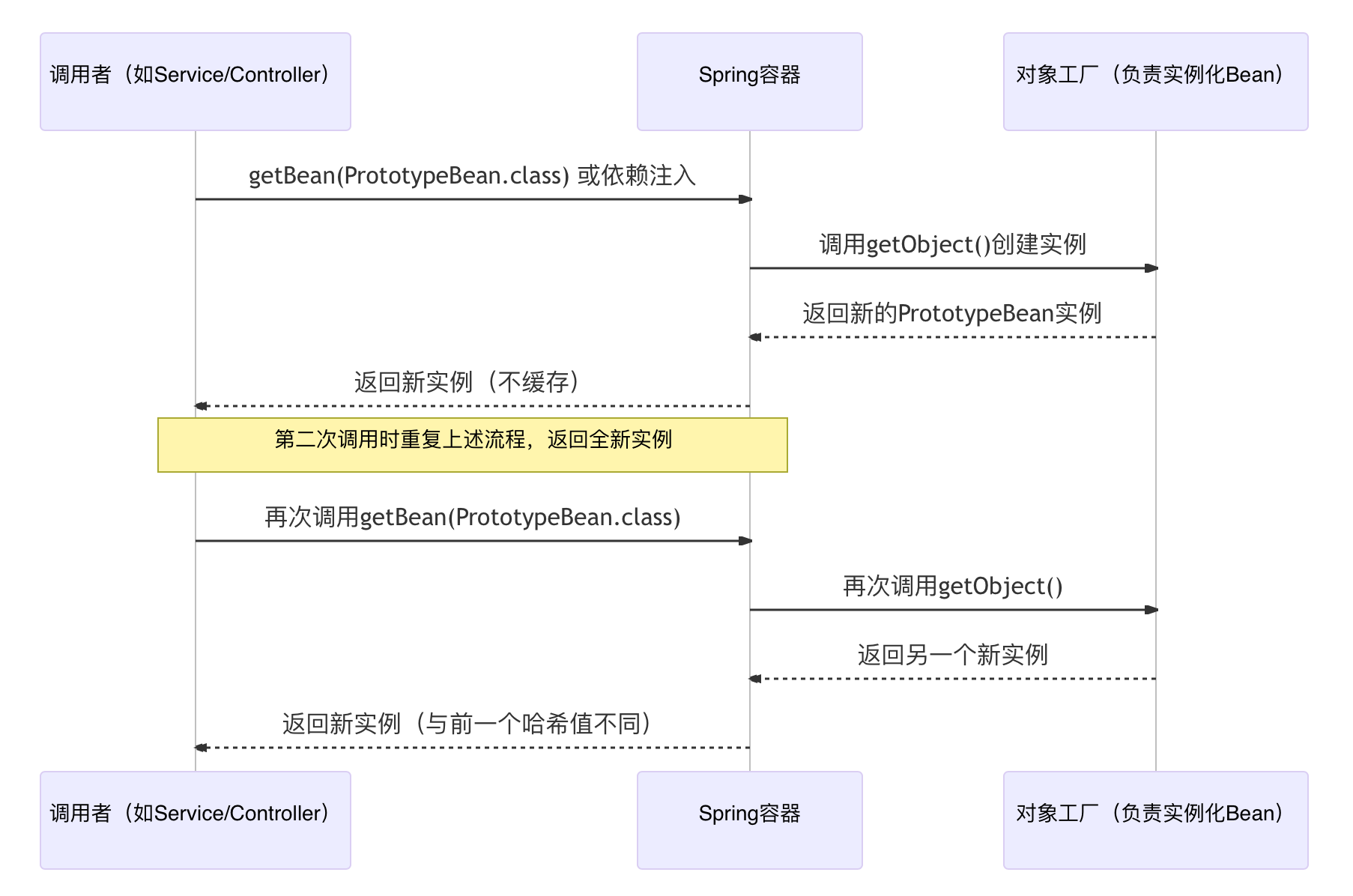
ObjectFactory是 Spring 内部用于延迟实例化的工具类,对于 prototype Bean,其getObject()方法会直接调用 Bean 的构造函数(或工厂方法),不经过任何缓存逻辑。- 当 prototype Bean 被单例 Bean 依赖时(如
@Autowired注入),单例 Bean 初始化时会触发一次ObjectFactory.getObject(),并永久持有该实例 —— 这就是 "prototype 特性失效" 的根源(需通过代理解决,见 1.4 节)。 - 由于 Spring 不管理 prototype 实例的销毁,若实例持有数据库连接、文件句柄等资源,必须手动调用销毁方法(如
close()),否则会导致资源泄漏。
1.3 request作用域:与请求生命周期绑定的魔法
request作用域的实现更为复杂,其核心是RequestScope类与RequestContextHolder的协同工作:
public class RequestScope implements Scope {
@Override
public Object get(String name, ObjectFactory<?> objectFactory) {
// 从当前线程获取请求上下文
RequestAttributes attributes = RequestContextHolder.currentRequestAttributes();
// 尝试从请求上下文获取已有实例
Object scopedObject = attributes.getAttribute(name, RequestAttributes.SCOPE_REQUEST);
if (scopedObject == null) {
// 首次使用,创建实例并存入请求上下文
scopedObject = objectFactory.getObject();
attributes.setAttribute(name, scopedObject, RequestAttributes.SCOPE_REQUEST);
}
return scopedObject;
}
@Override
public void registerDestructionCallback(String name, Runnable callback) {
RequestAttributes attributes = RequestContextHolder.currentRequestAttributes();
// 注册请求完成时的销毁回调
attributes.registerDestructionCallback(name, callback, RequestAttributes.SCOPE_REQUEST);
}
// 其他方法省略
}
RequestContextHolder是整个机制的核心,它通过ThreadLocal存储当前请求的上下文:
public abstract class RequestContextHolder {
// 存储请求上下文的ThreadLocal
private static final ThreadLocal<RequestAttributes> requestAttributesHolder =
new NamedThreadLocal<>("Request attributes");
// 设置当前线程的请求上下文
public static void setRequestAttributes(RequestAttributes attributes) {
requestAttributesHolder.set(attributes);
}
// 获取当前线程的请求上下文
public static RequestAttributes currentRequestAttributes() throws IllegalStateException {
RequestAttributes attributes = getRequestAttributes();
if (attributes == null) {
throw new IllegalStateException("No thread-bound request found");
}
return attributes;
}
// 其他方法省略
}
关键特性:
- request作用域的Bean实例存储在当前请求的上下文中,同一请求内多次获取会返回同一个实例。
- 请求处理完成后,
RequestContextFilter会自动清除ThreadLocal中的上下文,并触发Bean的销毁回调。 - 若在非请求线程(如定时任务线程、异步线程)中获取request作用域Bean,会因
ThreadLocal中无上下文而抛出异常。
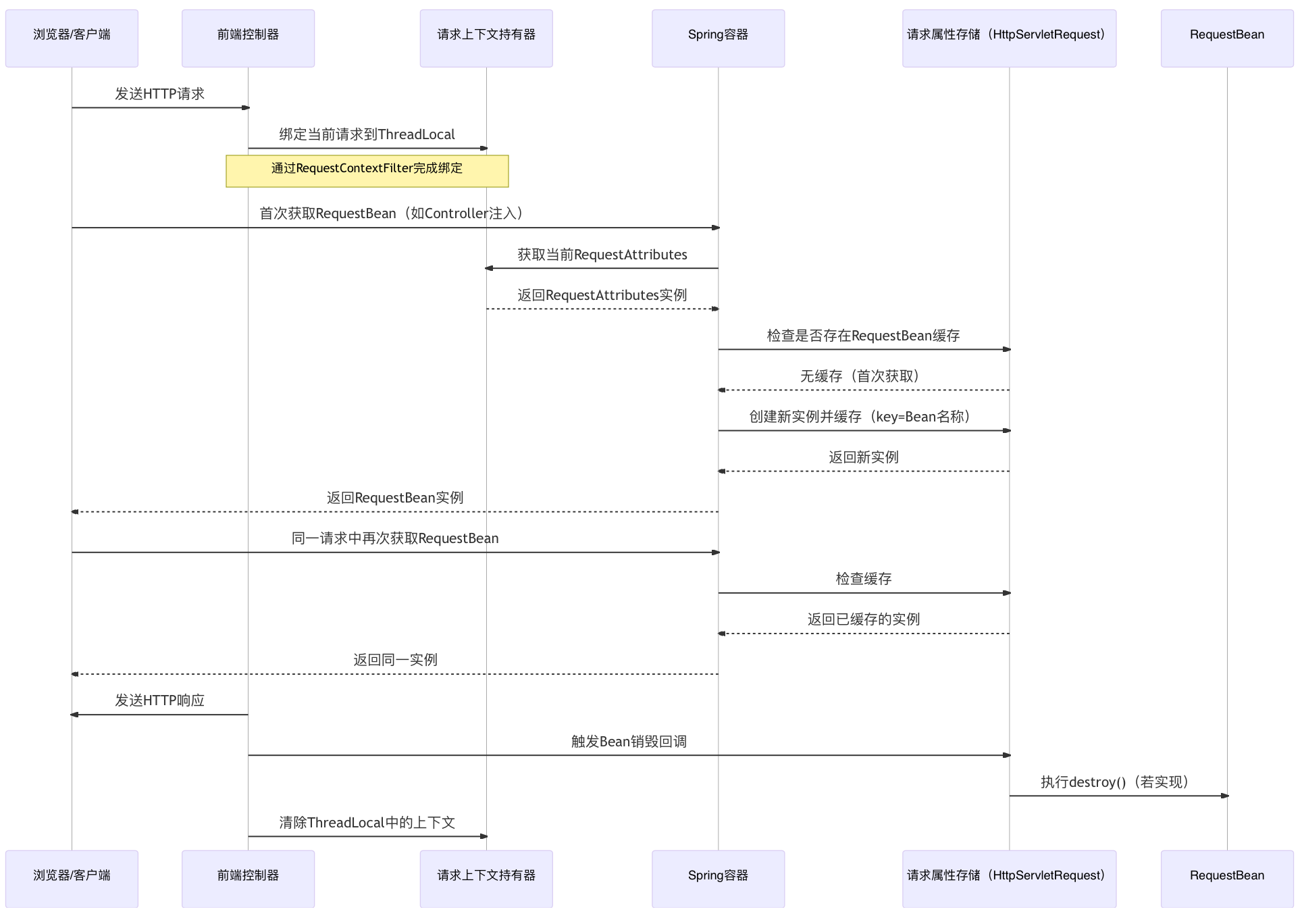
RequestContextHolder的ThreadLocal绑定发生在请求进入DispatcherServlet之前(由RequestContextFilter或RequestContextListener完成),确保后续所有 Bean 获取操作都能感知当前请求。- 缓存的
RequestAttributes实际存储在HttpServletRequest的属性中(request.setAttribute(beanName, instance)),因此实例生命周期与请求完全绑定。 - 若在请求处理完成后(
DispatcherServlet已清除上下文)尝试获取 request 作用域 Bean,会触发IllegalStateException: No thread-bound request found,这是因为ThreadLocal中已无可用上下文。
1.4 作用域代理:跨作用域依赖的桥梁
当低生命周期作用域(如prototype/request)被高生命周期作用域(如singleton)依赖时,直接注入会导致实例被长期持有。Spring通过作用域代理解决这一问题,其本质是生成一个"代理对象",替代真实Bean注入到依赖方,每次调用代理的方法时,都会动态获取最新的目标实例。
作用域代理有两种模式:
ScopedProxyMode.INTERFACE:基于JDK动态代理,要求目标Bean实现接口。ScopedProxyMode.TARGET_CLASS:基于CGLIB生成目标类的子类,适用于无接口的类。
以request作用域为例,代理的工作流程如下:
- 单例Bean注入的是request作用域Bean的代理对象。
- 当单例Bean调用代理对象的方法时,代理会从
RequestContextHolder获取当前请求的上下文。 - 从上下文取出真实的request作用域Bean实例,调用其方法。
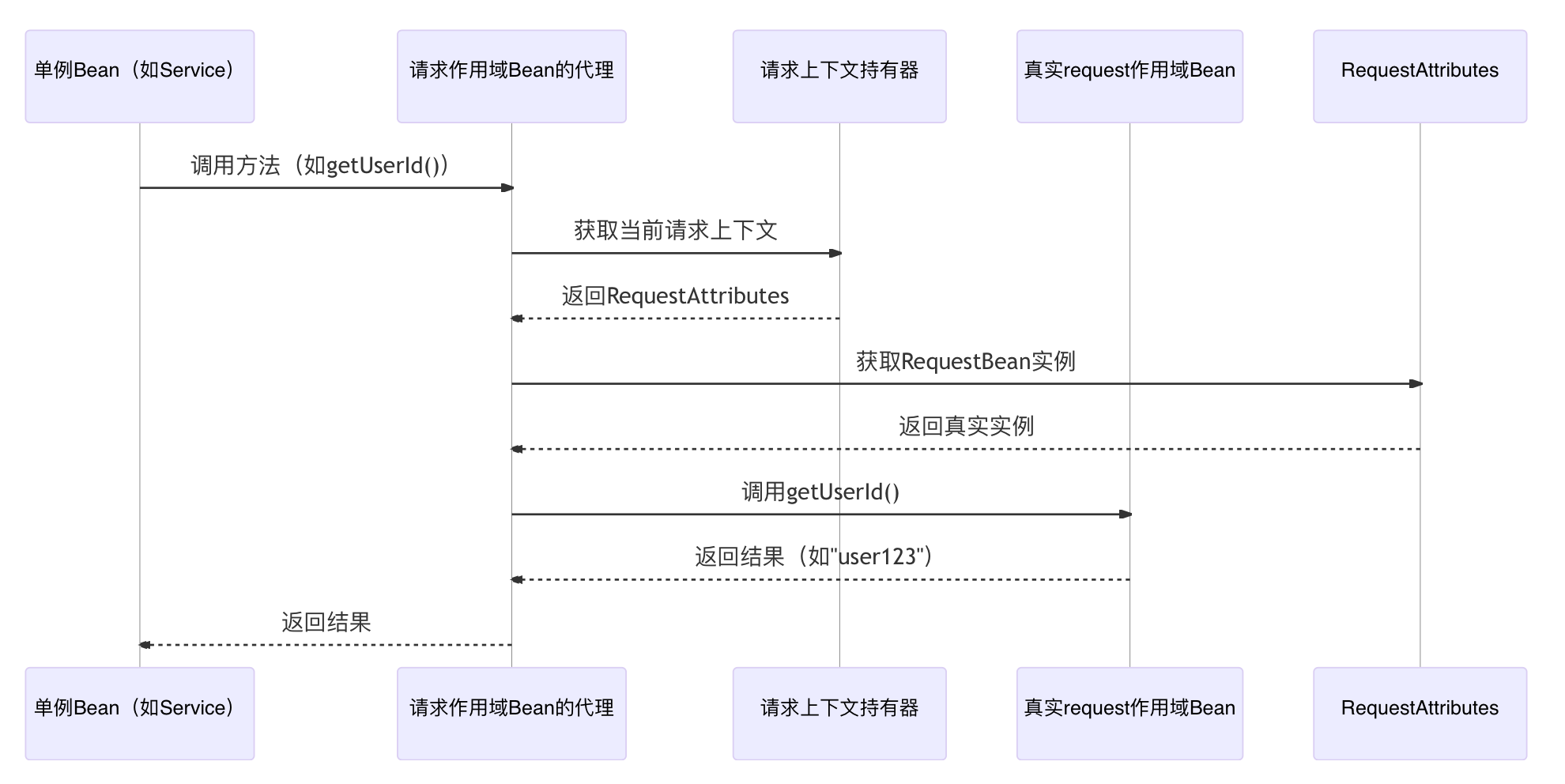
- 代理对象在单例 Bean 初始化时被注入,而非真实的 request/prototype 实例。代理的类名通常带有
$Proxy(JDK 代理)或$$EnhancerByCGLIB$$(CGLIB 代理)后缀。 - 每次调用代理方法时,都会重新从上下文获取实例,因此即使单例 Bean 长期存在,也能始终访问当前请求的最新实例。
- 若代理的是 prototype 作用域 Bean,流程类似:代理会在每次方法调用时通过
Container.getBean()获取新实例,确保 prototype 的 "每次获取新实例" 特性生效。
二、冲突的本质:两种作用域的语义互斥
@Scope("prototype")与@RequestScope的冲突并非Spring的设计缺陷,而是作用域语义的根本对立。理解这种对立的本质,是解决冲突的前提。
2.1 生命周期边界的冲突
prototype作用域的生命周期边界是"获取与丢弃":每次获取都是新实例,实例的销毁由开发者控制(或随GC回收),与任何外部上下文无关。
request作用域的生命周期边界是"请求开始与结束":实例在请求进入时创建,在响应发送后销毁,完全由HTTP请求的生命周期决定。
当两个注解同时标注在同一个Bean上时,Spring无法确定该以哪个边界作为实例销毁的触发点。实际运行中,Spring会根据注解的解析优先级覆盖其中一个作用域(通常@RequestScope优先级更高),导致被覆盖的作用域特性失效。
2.2 实例管理逻辑的冲突
prototype作用域的核心是"无状态管理":Spring不缓存任何实例,每次获取都通过ObjectFactory创建新对象,不参与实例的销毁过程。
request作用域的核心是"强状态管理":Spring通过RequestAttributes缓存实例,跟踪实例的创建与销毁,甚至支持销毁回调(如释放资源)。
这种管理逻辑的冲突会导致诡异的现象:例如,一个被标注为@Scope("prototype")的Bean,却在多次请求中复用同一个实例(因被request作用域的缓存逻辑覆盖);或者一个@RequestScope的Bean,在同一请求中被多次获取时返回不同实例(因被prototype的创建逻辑覆盖)。
2.3 线程绑定逻辑的冲突
prototype作用域与线程无关:实例可以在任意线程中创建和使用,不存在线程绑定关系。
request作用域则与线程强绑定:实例的存储依赖ThreadLocal,仅能在处理请求的线程中访问。
这种差异会导致跨线程场景下的严重问题。例如,若一个Bean同时标注两个注解,在异步线程中使用时:
- 若prototype作用域生效:实例可以被创建,但无法访问请求上下文(因异步线程无
ThreadLocal上下文)。 - 若request作用域生效:会因异步线程无上下文而抛出异常,或复用其他请求的上下文(线程复用导致
ThreadLocal污染)。
2.4 冲突的表现形式
在实际开发中,冲突的表现形式多样,常见的有以下几种:
表现1:作用域特性失效
例如,标注了@Scope("prototype")的Bean,在不同请求中被多次获取时返回同一个实例(因被request作用域的缓存覆盖)。
表现2:无请求上下文异常
在非请求线程中使用该Bean时,抛出IllegalStateException: No thread-bound request found(因request作用域生效,但无上下文)。
表现3:实例复用与数据污染
在高并发场景下,不同请求的线程复用了同一个Bean实例,导致A请求设置的字段被B请求读取(因prototype作用域生效,但缺乏线程隔离)。
表现4:代理逻辑混乱
两种作用域的代理逻辑叠加,导致代理链异常,出现ClassCastException(如CGLIB代理与JDK代理的类型转换失败)。
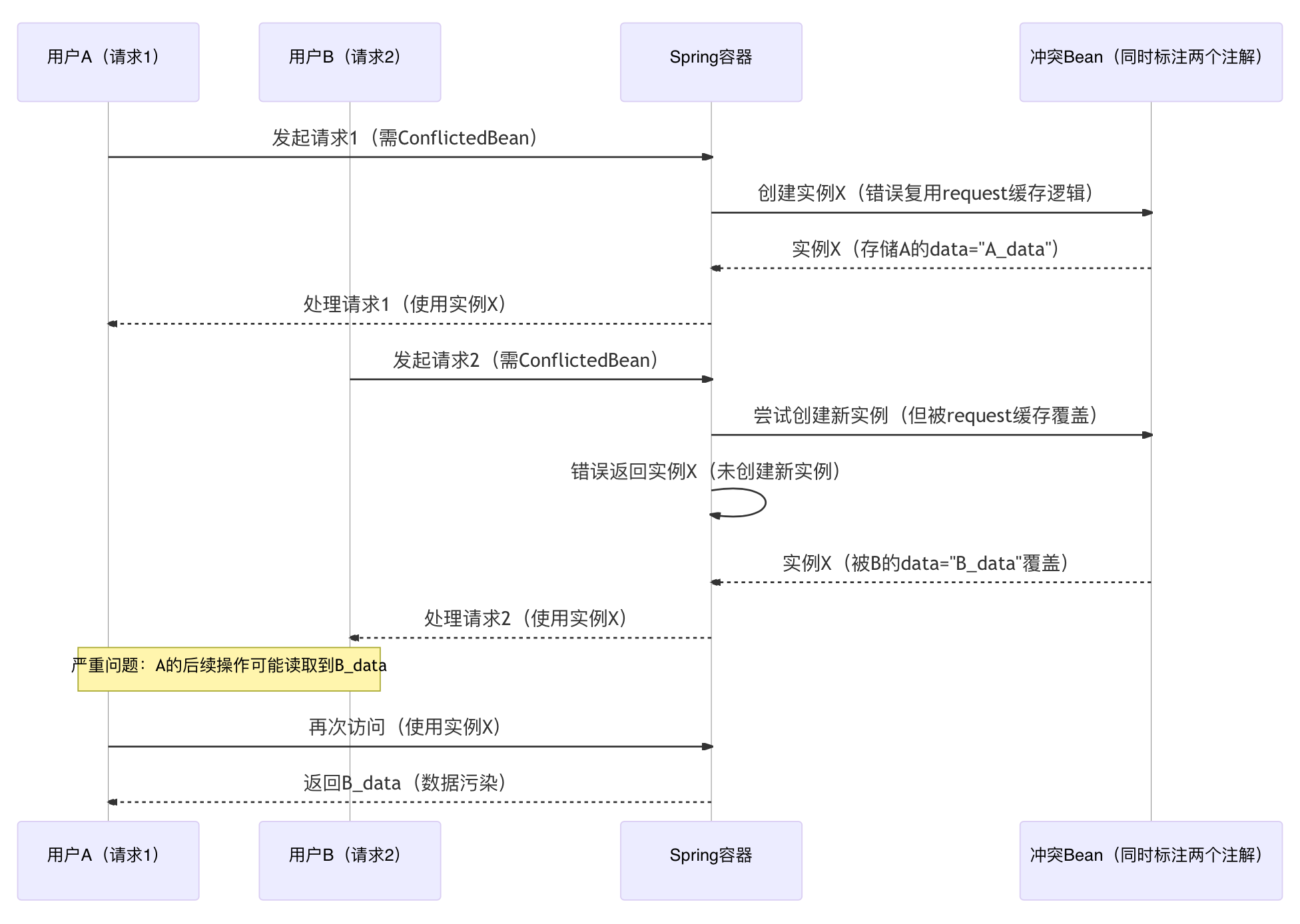
- 数据污染的根源是冲突导致 prototype 的 "无缓存" 特性失效,实例被错误地缓存到 request 上下文(或全局缓存)中。当多个请求复用同一实例时,后一个请求的 set 操作会覆盖前一个请求的数据。
- 这种问题在高并发场景下更难排查:由于线程调度的不确定性,数据污染可能间歇性出现,且日志中难以追踪实例的复用路径。
- 另一种常见异常场景是 "非请求线程访问 request 作用域":若冲突 Bean 被 prototype 特性主导,在异步线程中调用时,会因
ThreadLocal无上下文而抛出异常,但实例本身却可能被多个线程共享(因缺乏 request 的线程隔离)。
三、解决方案一:明确单一作用域,移除冲突注解
解决冲突最直接、最彻底的方案,是明确Bean的作用域需求,仅保留其中一个注解。这是遵循"单一职责原则"的必然选择。
3.1 保留@RequestScope(Web场景首选)
若Bean的职责是存储请求相关的上下文信息(如请求参数、用户令牌、临时状态),应仅保留@RequestScope:
import org.springframework.web.context.annotation.RequestScope;
import org.springframework.stereotype.Component;
@RequestScope // 仅保留请求作用域
@Component
public class RequestContextHolder {
private String requestId; // 请求唯一标识
private String userId; // 当前用户ID
private long startTime; // 请求开始时间
// 初始化方法:请求进入时调用
public void init(HttpServletRequest request) {
this.requestId = request.getHeader("X-Request-ID");
this.userId = request.getParameter("user_id");
this.startTime = System.currentTimeMillis();
}
// 统计请求处理耗时
public long getProcessTime() {
return System.currentTimeMillis() - startTime;
}
// getter/setter省略
}
适用场景:
- 需要在多个组件间共享请求相关数据(如Controller→Service→DAO)。
- 需在请求结束时执行清理操作(如释放资源、记录日志)。
优势:
- 自动与请求生命周期绑定,无需手动管理实例创建与销毁。
- 天然支持多线程隔离,避免并发数据污染。
3.2 保留@Scope("prototype")(灵活创建场景)
若Bean需要更灵活的实例创建(如在循环中多次创建,或根据不同参数初始化),应仅保留@Scope("prototype"):
import org.springframework.context.annotation.Scope;
import org.springframework.stereotype.Component;
@Scope("prototype") // 仅保留原型作用域
@Component
public class DynamicQueryBuilder {
private String tableName;
private List<String> conditions = new ArrayList<>();
// 原型Bean的初始化方法(需手动调用)
public void init(String tableName) {
this.tableName = tableName;
}
public void addCondition(String condition) {
conditions.add(condition);
}
public String build() {
return "SELECT * FROM " + tableName +
" WHERE " + String.join(" AND ", conditions);
}
}
使用示例:
在Service中多次创建原型实例:
@Service
public class QueryService {
@Autowired
private ApplicationContext context;
public List<Map<String, Object>> queryMultiTables() {
List<Map<String, Object>> result = new ArrayList<>();
// 第一次创建:查询user表
DynamicQueryBuilder userQuery = context.getBean(DynamicQueryBuilder.class);
userQuery.init("user");
userQuery.addCondition("status = 'active'");
result.add(jdbcTemplate.queryForMap(userQuery.build()));
// 第二次创建:查询order表
DynamicQueryBuilder orderQuery = context.getBean(DynamicQueryBuilder.class);
orderQuery.init("order");
orderQuery.addCondition("amount > 1000");
result.add(jdbcTemplate.queryForMap(orderQuery.build()));
return result;
}
}
适用场景:
- 需要根据不同参数动态创建实例(如动态SQL构建、命令模式实现)。
- 实例生命周期与请求无关(如批处理任务中多次创建临时对象)。
优势:
- 实例创建完全由开发者控制,灵活度高。
- 不依赖任何Web上下文,可在非Web环境(如单元测试、定时任务)中使用。
3.3 如何判断应保留哪个注解?
选择作用域的核心依据是Bean的职责与生命周期需求,可通过以下3个问题判断:
是否依赖HTTP请求上下文?
若是(如需要获取请求头、参数),选
@RequestScope;否则,考虑@Scope("prototype")。实例是否需要跨组件共享?
若是(如Controller和Service都需要访问),选
@RequestScope(自动在请求内共享);若仅在单一组件内使用,选@Scope("prototype")。是否需要在非请求场景使用?
若是(如定时任务、异步任务),必须选
@Scope("prototype");若仅在Web请求中使用,两者皆可(根据前两个问题判断)。
四、解决方案二:代理注入模式,分离作用域职责
若业务需要同时用到prototype和request作用域的特性(如在原型Bean中访问请求上下文),不应在同一个Bean上标注两个注解,而应通过代理注入将两者分离到不同Bean中,形成"原型Bean依赖请求Bean"的组合关系。
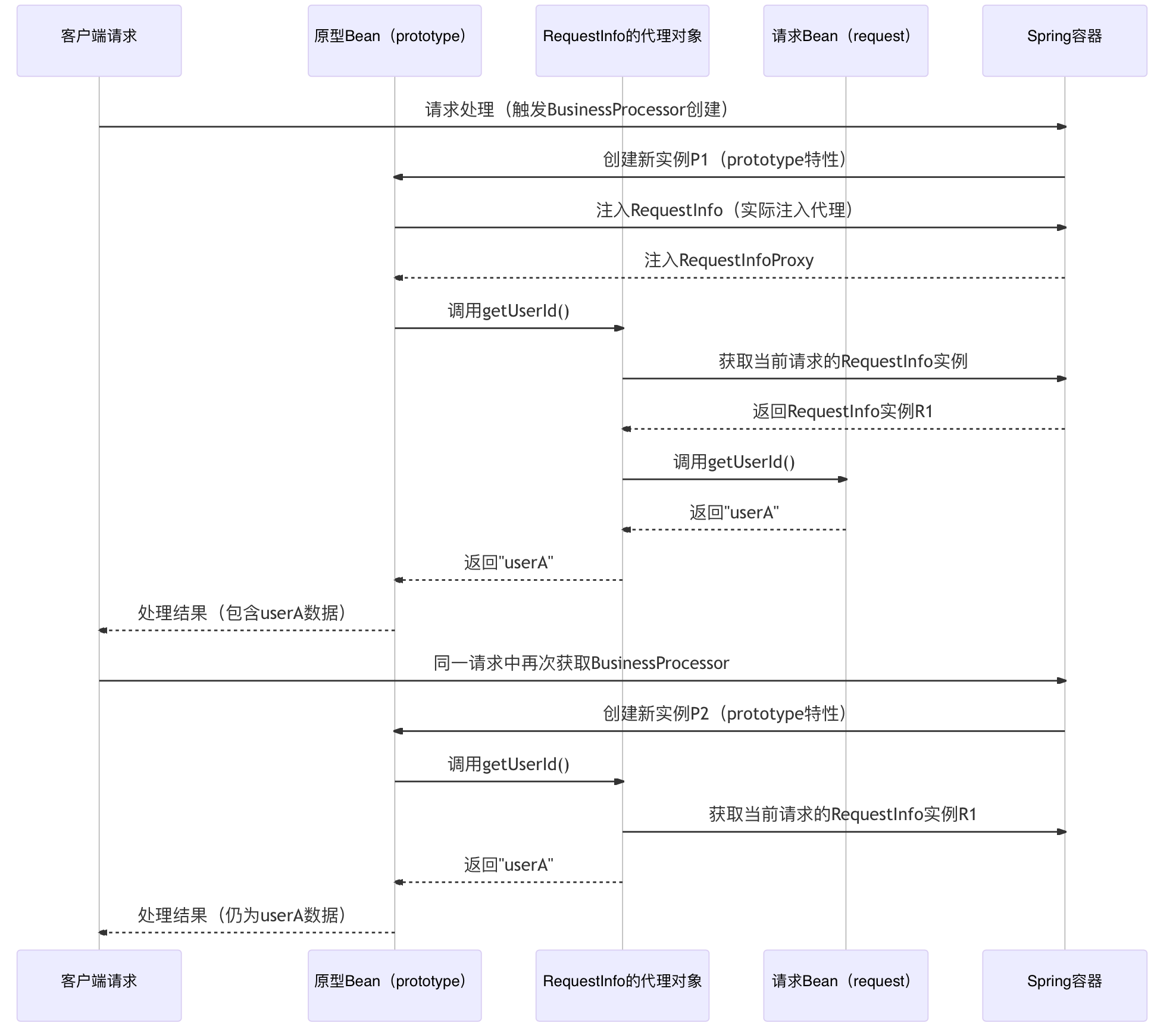
4.1 实现原理
- 定义一个request作用域的Bean(
RequestInfo),专门存储请求相关信息。 - 定义一个prototype作用域的Bean(
BusinessProcessor),通过自动注入获取RequestInfo的代理对象。 - 当
BusinessProcessor的方法被调用时,代理会动态获取当前请求的RequestInfo实例,实现"原型Bean访问请求上下文"的需求。 - 核心优势是 "职责分离":
RequestInfo专注于请求上下文管理,BusinessProcessor专注于业务逻辑,两者通过代理建立松耦合依赖。 - 代理对象在这里起到 "桥梁" 作用:它既满足了
BusinessProcessor(原型)对RequestInfo(请求)的依赖,又确保每次访问都能获取当前请求的实例(而非初始化时的实例)。 - 与冲突模式相比,这种设计符合 "单一职责原则":每个 Bean 的作用域与其职责严格匹配,避免了 Spring 对作用域的歧义解析。
4.2 代码实现
步骤1:定义request作用域的Bean
@RequestScope
@Component
public class RequestInfo {
private String userId;
private String requestUrl;
// 请求进入时由拦截器初始化
public void setRequestData(HttpServletRequest request) {
this.userId = request.getParameter("user_id");
this.requestUrl = request.getRequestURI();
}
// getter方法
public String getUserId() { return userId; }
public String getRequestUrl() { return requestUrl; }
}
步骤2:定义prototype作用域的Bean,注入RequestInfo代理
@Scope("prototype")
@Component
public class BusinessProcessor {
// 注入RequestInfo的代理对象(自动生成)
@Autowired
private RequestInfo requestInfo;
private String processId; // 原型实例的唯一标识
public BusinessProcessor() {
this.processId = UUID.randomUUID().toString();
}
public void process() {
// 调用代理对象的方法,实际会获取当前请求的RequestInfo实例
String userId = requestInfo.getUserId();
String url = requestInfo.getRequestUrl();
System.out.printf(
"Process [ID: %s] - User %s accesses %s%n",
processId, userId, url
);
}
}
步骤3:在Controller中使用组合关系
@RestController
public class BusinessController {
@Autowired
private ApplicationContext context;
@GetMapping("/process")
public String process() {
// 每次请求创建新的BusinessProcessor实例(prototype特性)
BusinessProcessor processor1 = context.getBean(BusinessProcessor.class);
processor1.process();
// 同一请求中创建第二个实例(仍能访问当前请求的RequestInfo)
BusinessProcessor processor2 = context.getBean(BusinessProcessor.class);
processor2.process();
return "Process completed";
}
}
步骤4:配置RequestInfo初始化拦截器
为确保RequestInfo在请求进入时被正确初始化,需添加一个拦截器:
@Component
public class RequestInfoInterceptor implements HandlerInterceptor {
@Autowired
private RequestInfo requestInfo; // 注入当前请求的RequestInfo实例
@Override
public boolean preHandle(HttpServletRequest request, HttpServletResponse response, Object handler) {
requestInfo.setRequestData(request); // 初始化请求数据
return true;
}
}
// 注册拦截器
@Configuration
public class WebConfig implements WebMvcConfigurer {
@Autowired
private RequestInfoInterceptor interceptor;
@Override
public void addInterceptors(InterceptorRegistry registry) {
registry.addInterceptor(interceptor).addPathPatterns("/**");
}
}
4.3 运行效果与优势
运行效果:
当用户访问/process?user_id=123时,控制台输出:
Process [ID: a1b2c3] - User 123 accesses /process
Process [ID: d4e5f6] - User 123 accesses /process
可见,两个BusinessProcessor实例(prototype特性)都正确访问了当前请求的RequestInfo(request特性)。
优势:
- 两种作用域职责分离,避免直接冲突。
- 原型Bean通过代理间接访问请求上下文,兼顾灵活性与上下文感知能力。
- 符合"单一职责原则",代码可读性与可维护性更高。
五、解决方案三:@Lookup注解,动态获取原型实例
在单例Bean中使用prototype作用域Bean时,直接注入会导致实例被长期持有。@Lookup注解可以解决这一问题,同时避免与request作用域的冲突——通过在单例Bean中定义"获取原型实例的抽象方法",让Spring自动生成实现,确保每次调用都返回新实例。
5.1 实现原理
@Lookup注解的本质是方法注入:Spring会重写被注解的方法,使其每次调用时都通过getBean()获取最新的prototype实例。这种方式可以在单例Bean中动态获取原型实例,同时通过常规注入获取request作用域Bean(代理模式),实现两种作用域的协同工作。
5.2 代码实现
步骤1:定义prototype作用域的Bean
@Scope("prototype")
@Component
public class OrderProcessor {
private String orderId;
public void setOrderId(String orderId) {
this.orderId = orderId;
}
public void process() {
System.out.println("Processing order: " + orderId +
" (Instance: " + this.hashCode() + ")");
}
}
步骤2:定义request作用域的Bean
@RequestScope
@Component
public class UserSession {
private String userId;
public void setUserId(String userId) {
this.userId = userId;
}
public String getUserId() {
return userId;
}
}
步骤3:在单例Bean中使用@Lookup获取原型实例,注入request实例
@Service
public class OrderService {
// 注入request作用域的UserSession(代理对象)
@Autowired
private UserSession userSession;
// 定义获取原型实例的抽象方法,由Spring自动实现
@Lookup
public OrderProcessor getOrderProcessor() {
return null; // 实际实现会被Spring替换
}
public void processOrders(List<String> orderIds) {
String userId = userSession.getUserId();
System.out.println("User " + userId + " processing orders:");
// 每次调用getOrderProcessor()都返回新实例
for (String orderId : orderIds) {
OrderProcessor processor = getOrderProcessor();
processor.setOrderId(orderId);
processor.process();
}
}
}
步骤4:在Controller中触发业务逻辑
@RestController
public class OrderController {
@Autowired
private OrderService orderService;
@Autowired
private UserSession userSession; // 注入当前请求的UserSession
@PostMapping("/orders/process")
public String processOrders(@RequestParam List<String> orderIds) {
userSession.setUserId("user_123"); // 初始化当前用户ID
orderService.processOrders(orderIds);
return "Orders processed";
}
}
5.3 运行效果与优势
运行效果:
当调用/orders/process?orderIds=1001,1002时,输出:
User user_123 processing orders:
Processing order: 1001 (Instance: 123456)
Processing order: 1002 (Instance: 789012)
可见,OrderProcessor的两个实例哈希值不同(prototype特性),且UserSession正确获取了当前用户ID(request特性)。
优势:
- 无需手动调用
ApplicationContext.getBean(),代码更简洁。 - 单例Bean与原型Bean的依赖关系清晰,符合依赖注入原则。
- 两种作用域分别由不同Bean承担,彻底避免冲突。
六、解决方案四:手动获取实例,绕过自动注入
若对Spring的自动注入机制持谨慎态度,可通过手动从容器获取实例的方式,完全控制prototype和request作用域Bean的创建时机,从根源上避免注解冲突。这种方式虽然稍显繁琐,但灵活性最高,尤其适合复杂的业务场景。
6.1 实现原理
通过ApplicationContext或BeanFactory的getBean()方法手动获取实例:
- 对于prototype作用域,每次调用
getBean()都会返回新实例。 - 对于request作用域,
getBean()会从当前请求的上下文获取实例(需在请求线程中调用)。
这种方式完全绕开了注解冲突的可能性,因为两种作用域的Bean分别定义,各自承担单一职责。
6.2 代码实现
步骤1:定义prototype和request作用域的Bean(无冲突注解)
// prototype作用域:负责数据计算
@Scope("prototype")
@Component
public class DataCalculator {
private List<Long> data;
public void setData(List<Long> data) {
this.data = data;
}
public long sum() {
return data.stream().mapToLong(n -> n).sum();
}
}
// request作用域:负责存储请求元数据
@RequestScope
@Component
public class RequestMetadata {
private String clientIp;
private String requestTime;
public void setClientIp(String clientIp) {
this.clientIp = clientIp;
}
public void setRequestTime(String requestTime) {
this.requestTime = requestTime;
}
@Override
public String toString() {
return "Request from " + clientIp + " at " + requestTime;
}
}
步骤2:在Service中手动获取实例
@Service
public class DataService {
@Autowired
private ApplicationContext context;
public String processData(List<Long> data, HttpServletRequest request) {
// 手动获取prototype实例(每次调用创建新对象)
DataCalculator calculator1 = context.getBean(DataCalculator.class);
calculator1.setData(data);
long sum1 = calculator1.sum();
// 再次获取prototype实例(新对象)
DataCalculator calculator2 = context.getBean(DataCalculator.class);
calculator2.setData(Arrays.asList(sum1, 100L)); // 基于前一次计算结果
long total = calculator2.sum();
// 手动获取request实例(当前请求的上下文对象)
RequestMetadata metadata = context.getBean(RequestMetadata.class);
metadata.setClientIp(request.getRemoteAddr());
metadata.setRequestTime(new SimpleDateFormat("HH:mm:ss").format(new Date()));
return String.format(
"Total: %d, %s", total, metadata.toString()
);
}
}
步骤3:在Controller中调用Service
@RestController
public class DataController {
@Autowired
private DataService dataService;
@PostMapping("/data/process")
public String process(@RequestBody List<Long> data, HttpServletRequest request) {
return dataService.processData(data, request);
}
}
6.3 运行效果与注意事项
运行效果:
POST请求/data/process,传入[1,2,3],返回:
Total: 106, Request from 127.0.0.1 at 15:30:45
其中,1+2+3=6,6+100=106(prototype实例的计算逻辑),RequestMetadata正确记录了客户端IP和时间(request特性)。
注意事项:
- 手动获取request作用域Bean时,必须在请求处理线程中调用(如Controller方法、拦截器),否则会抛出无上下文异常。
- 频繁调用
getBean()可能影响性能,建议在服务层集中获取,而非在循环或高频方法中调用。
七、解决方案五:自定义作用域解析器,动态选择作用域
在某些特殊场景(如同一套代码需要同时支持Web和非Web环境),可能需要根据运行时环境动态选择作用域:Web环境下使用@RequestScope,非Web环境下使用@Scope("prototype")。此时,可通过自定义ScopeMetadataResolver实现作用域的动态选择,避免静态注解冲突。
7.1 实现原理
Spring在解析Bean的作用域时,会委托ScopeMetadataResolver处理注解信息。通过自定义该接口的实现,我们可以:
- 检测当前运行环境(Web或非Web)。
- 若为Web环境,优先选择
request作用域。 - 若为非Web环境,自动切换为
prototype作用域。
7.2 代码实现
步骤1:自定义ScopeMetadataResolver
import org.springframework.beans.factory.config.BeanDefinition;
import org.springframework.context.annotation.AnnotationScopeMetadataResolver;
import org.springframework.context.annotation.ScopeMetadata;
import org.springframework.web.context.WebApplicationContext;
public class EnvironmentAwareScopeResolver extends AnnotationScopeMetadataResolver {
// 判断是否为Web环境(通过是否存在WebApplicationContext类)
private static final boolean IS_WEB_ENV = isWebEnvironment();
private static boolean isWebEnvironment() {
try {
Class.forName("org.springframework.web.context.WebApplicationContext");
return true;
} catch (ClassNotFoundException e) {
return false;
}
}
@Override
public ScopeMetadata resolveScopeMetadata(BeanDefinition definition) {
ScopeMetadata metadata = super.resolveScopeMetadata(definition);
// 若当前是Web环境,且作用域是prototype,则切换为request
if (IS_WEB_ENV && "prototype".equals(metadata.getScopeName())) {
metadata.setScopeName(WebApplicationContext.SCOPE_REQUEST);
// 设置request作用域默认的代理模式
metadata.setScopedProxyMode(ScopedProxyMode.TARGET_CLASS);
}
// 若当前是非Web环境,且作用域是request,则切换为prototype
if (!IS_WEB_ENV && WebApplicationContext.SCOPE_REQUEST.equals(metadata.getScopeName())) {
metadata.setScopeName("prototype");
metadata.setScopedProxyMode(ScopedProxyMode.DEFAULT);
}
return metadata;
}
}
步骤2:在启动类中配置自定义解析器
import org.springframework.boot.SpringApplication;
import org.springframework.boot.autoconfigure.SpringBootApplication;
import org.springframework.context.annotation.ComponentScan;
@SpringBootApplication
// 指定自定义的作用域解析器
@ComponentScan(scopeResolver = EnvironmentAwareScopeResolver.class)
public class DynamicScopeApplication {
public static void main(String[] args) {
SpringApplication.run(DynamicScopeApplication.class, args);
}
}
步骤3:定义Bean时使用基础注解
import org.springframework.context.annotation.Scope;
import org.springframework.stereotype.Component;
import org.springframework.web.context.WebApplicationContext;
// 在Web环境下会被解析为request作用域,非Web环境下为prototype
@Component
@Scope("prototype")
public class EnvironmentAwareBean {
private String data;
public void setData(String data) {
this.data = data;
}
public String getData() {
return data;
}
}
7.3 适用场景与风险
适用场景:
- 开发通用组件库,需同时支持Web和非Web环境。
- 同一Bean在不同环境下有不同的生命周期需求(如Web环境绑定请求,批处理环境每次创建新实例)。
风险与限制:
- 动态切换作用域可能导致代码行为难以预测,增加调试难度。
- 需确保Bean的逻辑同时兼容两种作用域(如避免在非Web环境下依赖请求上下文)。
- 自定义解析器会全局生效,可能影响其他Bean的作用域解析,需谨慎测试。
八、解决方案六:使用ObjectProvider,延迟获取实例
ObjectProvider是Spring 4.3引入的接口,用于延迟获取Bean实例,尤其适合处理prototype作用域的Bean。通过ObjectProvider,可以在request作用域的Bean中动态获取prototype实例,避免两种作用域的直接冲突。
8.1 实现原理
ObjectProvider的getObject()方法会每次返回新的prototype实例(因prototype作用域的特性)。在request作用域的Bean中注入ObjectProvider<PrototypeBean>,可以:
- 保持request作用域Bean的单一实例(在请求内)。
- 每次调用
getObject()获取新的prototype实例,满足灵活创建的需求。
8.2 代码实现
步骤1:定义prototype作用域的Bean
@Scope("prototype")
@Component
public class ReportGenerator {
private String reportType;
public void setReportType(String reportType) {
this.reportType = reportType;
}
public String generate() {
return String.format("Report [%s] - Instance: %s",
reportType, this.hashCode());
}
}
步骤2:在request作用域的Bean中注入ObjectProvider
@RequestScope
@Component
public class ReportService {
// 注入prototype Bean的提供者
private final ObjectProvider<ReportGenerator> reportGeneratorProvider;
// 构造函数注入(推荐)
@Autowired
public ReportService(ObjectProvider<ReportGenerator> reportGeneratorProvider) {
this.reportGeneratorProvider = reportGeneratorProvider;
}
public List<String> generateReports(List<String> types) {
List<String> reports = new ArrayList<>();
for (String type : types) {
// 每次调用getObject()获取新的prototype实例
ReportGenerator generator = reportGeneratorProvider.getObject();
generator.setReportType(type);
reports.add(generator.generate());
}
return reports;
}
}
步骤3:在Controller中使用ReportService
@RestController
public class ReportController {
@Autowired
private ReportService reportService;
@GetMapping("/reports")
public List<String> getReports(@RequestParam List<String> types) {
return reportService.generateReports(types);
}
}
8.3 运行效果与优势
运行效果:
访问/reports?types=summary,detail,返回:
[
"Report [summary] - Instance: 123456",
"Report [detail] - Instance: 789012"
]
可见,ReportGenerator的两个实例哈希值不同(prototype特性),且ReportService在请求内是单一实例(request特性)。
优势:
- 无需手动调用
ApplicationContext,符合依赖注入的设计理念。 ObjectProvider支持泛型和工厂方法,使用灵活。- 代码简洁,易于理解和维护。
九、解决方案七:线程本地存储,手动管理上下文
对于极端复杂的场景(如需要在异步线程中同时使用prototype和request相关数据),可以通过ThreadLocal手动管理上下文,完全绕开Spring的作用域机制。这种方式虽然侵入性强,但能彻底掌控实例的创建与上下文的传播。
9.1 实现原理
- 定义一个
ContextHolder类,通过ThreadLocal存储请求相关数据(替代request作用域)。 - 定义prototype作用域的Bean,在需要时从
ContextHolder获取上下文数据。 - 在请求进入时设置上下文,异步线程中通过
ThreadLocal传播上下文,请求结束时清理。
9.2 代码实现
步骤1:定义手动上下文管理器
public class ManualContextHolder {
// 存储请求上下文的ThreadLocal
private static final ThreadLocal<Map<String, Object>> context =
new ThreadLocal<>();
// 初始化上下文(请求进入时调用)
public static void init() {
context.set(new HashMap<>());
}
// 设置上下文属性
public static void setAttribute(String key, Object value) {
Map<String, Object> attributes = context.get();
if (attributes == null) {
throw new IllegalStateException("Context not initialized");
}
attributes.put(key, value);
}
// 获取上下文属性
public static Object getAttribute(String key) {
Map<String, Object> attributes = context.get();
return attributes == null ? null : attributes.get(key);
}
// 清理上下文(请求结束时调用)
public static void clear() {
context.remove();
}
// 复制当前上下文到新线程(用于异步场景)
public static Runnable wrap(Runnable task) {
Map<String, Object> currentContext = context.get();
return () -> {
try {
// 将当前线程的上下文复制到新线程
context.set(currentContext != null ? new HashMap<>(currentContext) : new HashMap<>());
task.run();
} finally {
context.remove();
}
};
}
}
步骤2:定义prototype作用域的Bean,使用手动上下文
@Scope("prototype")
@Component
public class AsyncProcessor {
public void process() {
// 从手动管理的上下文获取数据(替代request作用域)
String userId = (String) ManualContextHolder.getAttribute("userId");
String taskId = UUID.randomUUID().toString();
System.out.printf(
"Async process [ID: %s] - User %s processed (Instance: %s)%n",
taskId, userId, this.hashCode()
);
}
}
步骤3:在Controller中初始化上下文并触发异步任务
@RestController
public class AsyncController {
@Autowired
private AsyncProcessor processor; // 注入prototype Bean的代理
@Autowired
private TaskExecutor taskExecutor; // 异步任务执行器
@GetMapping("/async/process")
public String process(@RequestParam String userId) {
// 初始化手动上下文
ManualContextHolder.init();
ManualContextHolder.setAttribute("userId", userId);
try {
// 同步处理:获取新的prototype实例
AsyncProcessor syncProcessor = new AsyncProcessor();
syncProcessor.process();
// 异步处理:通过wrap方法传播上下文
taskExecutor.execute(ManualContextHolder.wrap(() -> {
AsyncProcessor asyncProcessor = new AsyncProcessor();
asyncProcessor.process();
}));
return "Processing started";
} finally {
// 清理上下文(确保执行)
ManualContextHolder.clear();
}
}
}
// 配置异步任务执行器
@Configuration
@EnableAsync
public class AsyncConfig {
@Bean
public TaskExecutor taskExecutor() {
ThreadPoolTaskExecutor executor = new ThreadPoolTaskExecutor();
executor.setCorePoolSize(5);
executor.initialize();
return executor;
}
}
9.3 运行效果与适用场景
运行效果:
访问/async/process?userId=456,输出:
Async process [ID: xyz123] - User 456 processed (Instance: 111222)
Async process [ID: abc789] - User 456 processed (Instance: 333444)
可见,同步和异步场景下的AsyncProcessor是不同实例(prototype特性),且都正确获取了userId(手动上下文的传播效果)。
适用场景:
- 需要在异步线程中访问请求上下文(Spring的request作用域默认不支持)。
- 对上下文传播有特殊需求(如自定义数据传递、跨线程池共享)。
缺点:
- 代码侵入性强,需要手动管理上下文的初始化与清理。
- 若清理不当,
ThreadLocal可能导致内存泄漏或线程污染。
十、最佳实践:规避冲突的7条原则
经过对冲突本质的分析和7种解决方案的实践,我们可以总结出以下7条原则,帮助开发者在日常开发中规避@Scope("prototype")与@RequestScope的冲突:
1. 单一职责原则:一个Bean只承担一种作用域
永远不要在同一个Bean上同时标注@Scope("prototype")和@RequestScope。每个Bean应专注于单一职责,其作用域应与其职责严格匹配。
2. 优先使用组合而非注解叠加
当需要同时用到两种作用域的特性时,采用"request作用域Bean + prototype作用域Bean"的组合模式,通过代理或手动获取实现协同,而非在一个Bean上叠加注解。
3. 明确作用域的生命周期边界
在使用作用域前,务必明确其生命周期边界:
- prototype:从
getBean()到手动丢弃(或GC回收)。 - request:从
HttpServletRequest创建到HttpServletResponse发送。
4. 慎用作用域代理,理解其原理
作用域代理虽能解决跨作用域依赖,但也会增加代码复杂度和性能开销。使用前需明确:
- 代理的类型(JDK/CGLIB)及适用场景。
- 代理方法调用的性能损耗(尤其高频调用场景)。
5. 非Web环境禁用request作用域
在定时任务、批处理等非Web环境中,禁止使用@RequestScope,避免因无请求上下文导致的异常。此时应使用prototype作用域或手动管理实例。
6. 异步场景显式传播上下文
在异步任务中使用request相关数据时,需通过以下方式显式传播上下文:
- 使用
DelegatingRequestContextAsyncTaskExecutor(Spring提供)。 - 手动通过
ThreadLocal复制上下文(如解决方案七中的ManualContextHolder.wrap())。
7. 定期检测作用域使用合理性
通过以下手段检测作用域使用是否合理:
单元测试:验证prototype作用域的Bean每次获取都是新实例。
集成测试:验证request作用域的Bean在不同请求中是否隔离。
代码审查:重点检查跨作用域依赖的代理配置。
Spring Boot Actuator + BeanDefinitionEndpoint:
暴露
/actuator/beans端点,查看所有Bean的作用域配置,筛选出"同时标注prototype和request"的异常Bean。示例响应片段:{ "beans": { "conflictedBean": { "scope": "request", // 异常:实际应为prototype,但被覆盖 "dependencies": [], "resource": "com.example.ConflictedBean" } } }自定义BeanPostProcessor:
在Bean初始化前检查作用域注解冲突,主动抛出异常:
@Component public class ScopeConflictChecker implements BeanPostProcessor { @Override public Object postProcessBeforeInitialization(Object bean, String beanName) { Class<?> clazz = bean.getClass(); boolean hasPrototype = clazz.isAnnotationPresent(Scope.class) && "prototype".equals(clazz.getAnnotation(Scope.class).value()); boolean hasRequest = clazz.isAnnotationPresent(RequestScope.class); if (hasPrototype && hasRequest) { throw new IllegalStateException("Bean " + beanName + " has conflicting scopes!"); } return bean; } }实例哈希值追踪:
在Bean中添加
hashCode()日志,验证prototype是否每次获取都是新实例,request是否在不同请求中隔离:@Slf4j @RequestScope public class RequestBean { public RequestBean() { log.info("RequestBean instance created: {}", hashCode()); } } // 正常日志:不同请求的hashCode不同;异常日志:同一请求多次创建或不同请求复用
结语:理解本质,而非依赖工具
@Scope("prototype")与@RequestScope的冲突,表面是注解的使用问题,深层是对Spring作用域设计理念的理解不足。Spring的作用域机制并非简单的"实例创建规则",而是一套完整的生命周期管理体系,涉及实例创建、缓存、代理、销毁等多个环节。
解决冲突的核心,不是寻找更巧妙的注解组合,而是回归作用域的本质——根据Bean的职责选择合适的生命周期,并通过合理的代码结构(如组合、代理、手动获取)实现不同作用域的协同。
正如Spring框架的设计哲学:"约定优于配置",在作用域的使用上,遵循单一职责、明确边界、合理组合的原则,才能从根本上规避冲突,构建出健壮、可维护的应用。
Spring 作用域冲突深度解析:@Scope("prototype")与@RequestScope的冲突与解决方案 | Honesty Blog